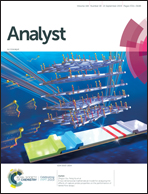A two-dimensional mathematical model for analyzing the effects of capture probe properties on the performance of lateral flow assays†
Abstract
Lateral flow assays (LFAs) are promising candidates in biomedical diagnosis fields due to their rapid, low-cost, and portable features. However, improving their sensitivity remains challenging due to the unclear roles of capture probes with different distribution formats on the particle transfer and capturing in the test line. Therefore, we designed experiments and observed an asymmetrical U-shaped distribution of control probes throughout the NC membrane thickness. Based on this outcome, a two-dimensional mathematical model based on the Langmuir surface reaction kinetics was developed to investigate the effect of capture probe distributions on LFA performance. A two-dimensional model was qualitatively validated by comparing with the experimental results and the simulations of the reported one-dimensional model. Then, a higher detection signal was achieved by using the U-shaped distribution of capture probes throughout the NC membrane thickness instead of a uniform distribution. Furthermore, when the NC membrane thickness was less than 110 μm, the ratio of the detection signal in the visible region to the signal in the total section at the test line was above 13%. A thin NC membrane will produce a strong detection signal in the visible region at the test line. The developed model is capable of providing direct predictions in designing highly sensitive LFAs.



 Please wait while we load your content...
Please wait while we load your content...